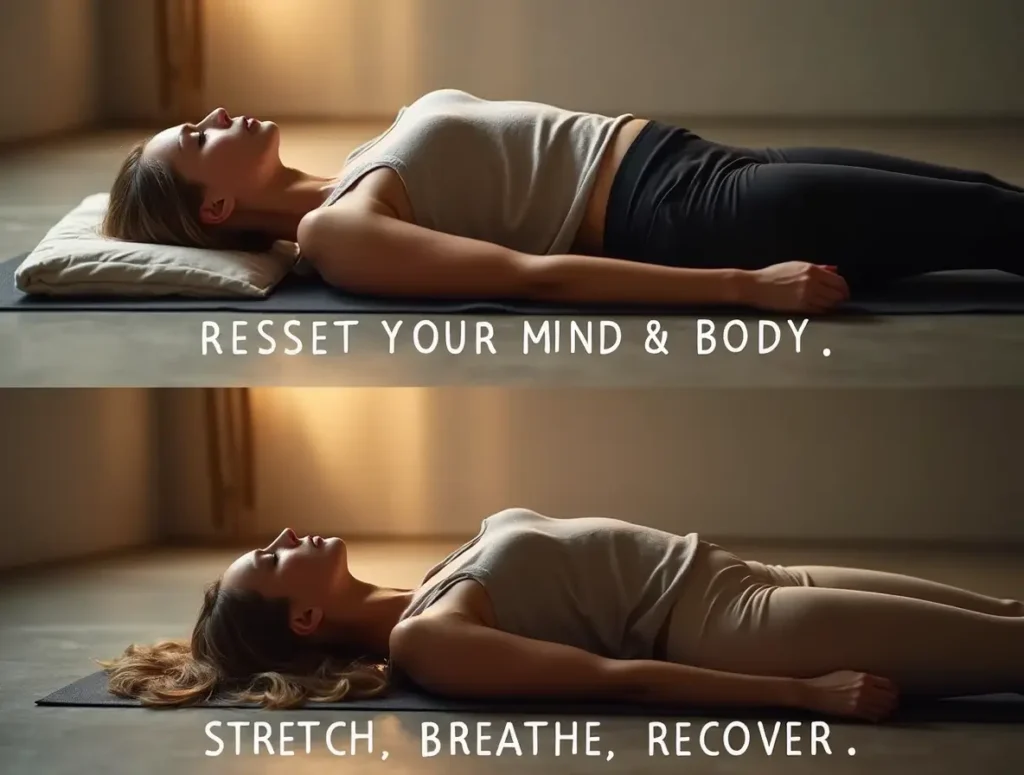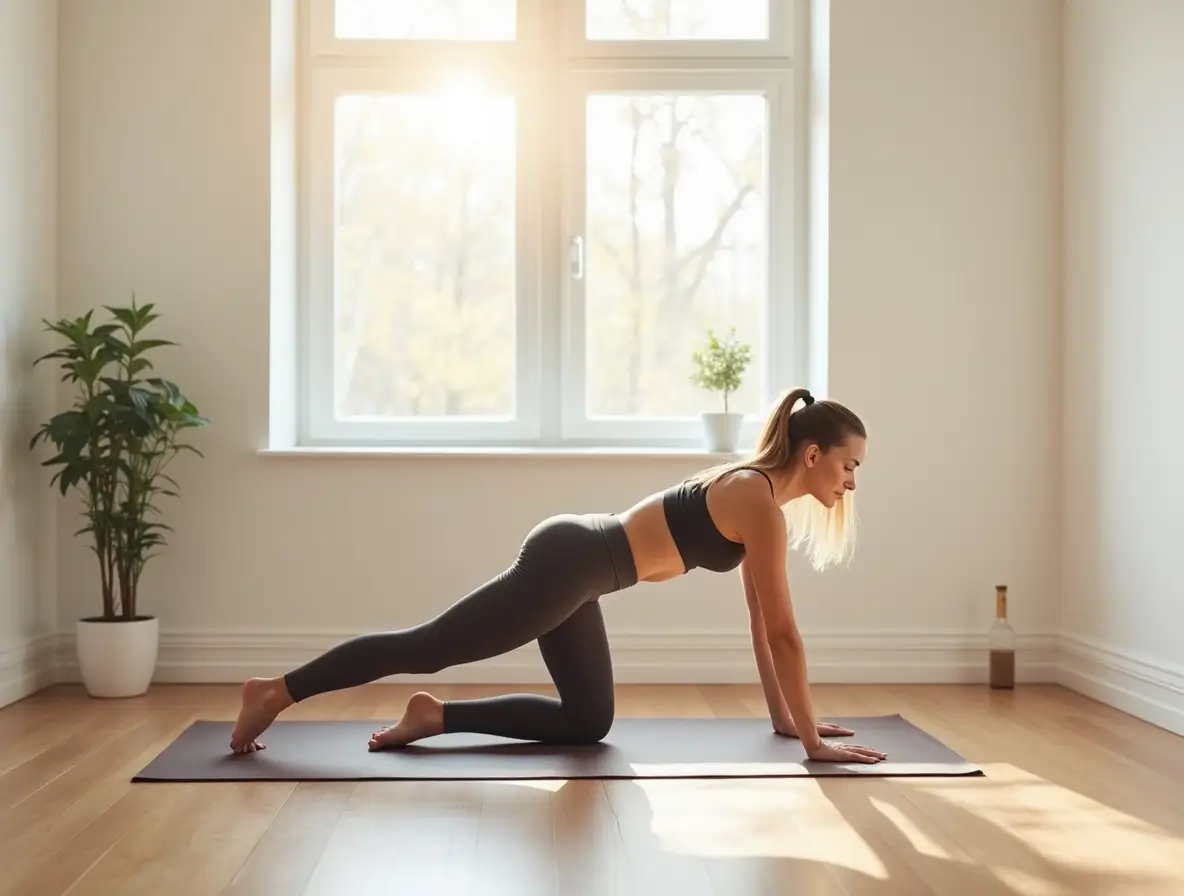Tight hips. Sore muscles. Stiff shoulders. If you’ve been hitting the gym hard but skipping your cooldowns, it’s time to make a change. One of the most overlooked tools in fitness isn’t a supplement or a workout — it’s a simple yoga stretch routine.
I’m Coach Travis, certified fitness coach and founder of AdvicesFitness.com, and in this post, I’m breaking down how a consistent yoga stretch practice can transform your performance, improve your recovery, and give your mind a much-needed reset. You don’t need to be flexible to start — you just need a few minutes and a willingness to grow.
Let’s stretch it out. Let’s go!
Table of Contents
What Exactly Is a Yoga Stretch?
When we talk about yoga stretch, we’re talking about a functional combination of traditional yoga poses blended with mobility-enhancing static and dynamic stretches. You’re not chanting or holding poses for an hour. You’re moving with intention — to recover better, move freely, and reduce tension.
Think of it as:
- Active recovery for sore muscles
- Mobility training for better movement patterns
- Mental clarity after a stressful day
- A performance enhancer for any sport or workout style
Whether you’re lifting weights, running, cycling, or just starting out — incorporating a yoga stretch sequence can level up your game and help you feel great daily.
Why You Need a Yoga Stretch Routine (Even If You’re Not “Into Yoga”)
Let’s break down what a consistent yoga stretch routine can offer. These benefits aren’t just anecdotal — they’re backed by real-world application and science.
1. Improves Flexibility & Range of Motion
Tight muscles restrict movement. Stretching regularly allows your joints to move more freely, which improves exercise performance and reduces injury risk.
2. Speeds Up Recovery
Yoga stretching promotes blood flow and lymphatic circulation, helping deliver oxygen and nutrients to muscles faster while clearing waste products. Less soreness, quicker bounce-back.
3. Reduces Muscle Tightness and Imbalances
Chronic tightness (e.g., hamstrings, hip flexors, chest) creates postural issues. A structured routine releases these areas, improving alignment and muscular balance.
4. Reduces Stress and Anxiety
Slow breathing + intentional movement = activation of the parasympathetic nervous system (the “rest and digest” state). This lowers cortisol and eases mental fatigue.
5. Improves Sleep and Focus
Yoga-based stretching before bed helps calm your mind and body, improving sleep quality and cognitive performance the next day.
Who Should Be Doing Yoga Stretch?

Short answer? Everyone.
But it’s especially beneficial if:
- You lift weights or do HIIT and feel tight or stiff
- You sit for long hours (desk job or commuting)
- You’re over 30 and want to stay mobile and pain-free
- You experience regular stress or sleep issues
- You’re recovering from injury and need gentle movement
Coach Travis says: “Yoga stretching isn’t a trend. It’s a tool. And the best athletes in the world use it.”
A Beginner-Friendly Yoga Stretch Routine (10–15 Minutes)
You don’t need fancy poses. Start with a foundational full-body stretch sequence that opens major muscle groups and enhances breathing.
Coach Travis’s Go-To Flow:
- Child’s Pose (60 sec)
Stretches spine, hips, and shoulders. Breathe deeply into the back body. - Cat-Cow Flow (60 sec)
Loosens the spine, wakes up the nervous system, and builds breath awareness. - Downward Dog (30–45 sec)
Opens hamstrings, calves, and shoulders. Keep knees slightly bent if tight. - Low Lunge (Right + Left, 60 sec each)
Deep hip opener. Drop the back knee, press forward gently, and breathe into the stretch. - Seated Forward Fold (60 sec)
Targets hamstrings, lower back, and calms the mind. - Seated Twist (30 sec each side)
Improves spinal rotation, helps with digestion and core engagement. - Supine Figure 4 Stretch (45 sec each leg)
Opens glutes, piriformis, and relieves lower back tension. - Savasana + Breath Work (2–3 min)
Lie down flat, hands at your sides. Inhale deeply through your nose, exhale slowly through your mouth. Let your body fully relax.
Total time: ~12–15 minutes
Tip: Use a yoga mat or towel, and play soft music or nature sounds to enhance focus.
Best Times to Incorporate Yoga Stretching
A yoga stretch is flexible (pun intended). You can add it to your day based on your needs:
Timing Guide:
- Morning Routine: Wake up your body, reduce stiffness, and improve mood
- Post-Workout: Aid muscle recovery and prevent tightness
- Before Bed: Relax your nervous system and improve sleep
- Rest Days: Use it as active recovery to support circulation
Coach Travis says: “Stretching isn’t optional — it’s part of training smarter, not harder.”
How Often Should You Do a Yoga Stretch Routine?
If your goal is general flexibility and stress reduction, 3–5 sessions per week is a great starting point.
If you’re training hard, lifting, or running often, try:
- 10 minutes after each workout
- Longer 20–30 minute flows on rest days
Consistency beats intensity. You don’t need to stretch for an hour — just show up regularly.

Avoid These Common Yoga Stretching Mistakes
Forcing a pose: Stretching should create tension, not pain. Ease into it.
Holding your breath: Always breathe deeply — it amplifies the benefits.
Skipping warm-ups: If you’re tight, try 2 minutes of movement before stretching.
Only stretching one side: Symmetry matters. Balance both sides of the body.
Being inconsistent: One stretch session won’t change your life. Five a week will.
Real People. Real Results.
Nathan (35): “I started doing Travis’s yoga stretch flow every night. My lower back pain vanished, and I sleep better than I have in years.”
Michelle (40): “As a weightlifter, I never stretched. After 2 weeks of daily yoga stretch, my squats feel smoother and my posture improved.”
Tariq (32): “I added this routine to my lunch break. It clears my mind and resets my body. Total game-changer.”
Internal Link Suggestion
How to Stay Motivated When Results Are Slow
External Link Suggestion
Yoga for Flexibility – Healthline Guide
Final Thoughts from Coach Travis
Stretching is not just for recovery. It’s for clarity, longevity, and freedom of movement. Your fitness goals depend on your ability to move well and recover efficiently — and the yoga stretch is your secret weapon.
Coach Travis says: “Strong is good. But strong and mobile? That’s elite. Give your body the gift of yoga — and your mind will thank you too.”
Ready to loosen up, lean out, and level up?
Start your yoga stretch journey today — visit AdvicesFitness.com for more free routines, mobility hacks, and performance tools that keep your fitness future-proof.
Fitness or Food, Your Feedback Matters! Drop a Review! 🏋️♂️🍔
There are no reviews yet. Be the first one to write one.

